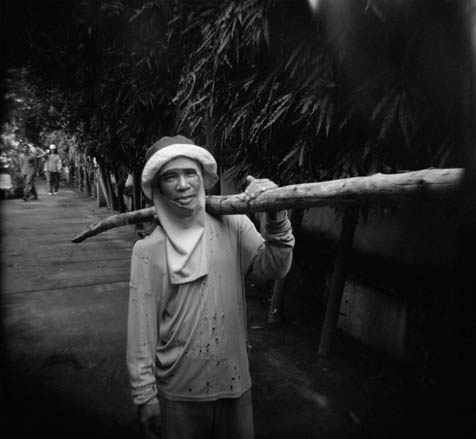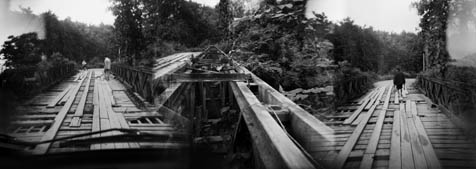Patricia Clarke and Ellen Kelley’s Correspondences
A Balance of Mediums

When Patricia Clarke volunteered, in 1979, to teach English to Hmong immigrants living in Isla Vista, she never envisioned that, 28 years later, she would photograph an impoverished Hmong village in the remote hinterlands of Laos. The photographs she took, now on show at the Architectural Foundation Gallery, form one half of an unusual and powerful artistic collaboration between Clarke and her close friend, poet Ellen Kelley.
Clarke and Kelley’s friendship dates back 30 years. Their children are close; they view each other’s families as extensions of their own. Almost since they first met, they have wanted to work on an artistic project together. Correspondences, an exhibit of 17 photographs Clarke took in Southeast Asia coupled with poems Kelley wrote in response to them, is the realization of that wish. Both the surface and the background of these works reverberate with personal trials and the pains of a troubled world, but they are also infused with an attitude of gentle acceptance.

It was struggles with physical health that finally moved photographer and writer to launch their collaboration. Kelley is a cancer survivor, and Clarke suffered a disabling back injury. In the aftermath of these traumas, both women felt the necessity to “reinvent” themselves. Kelley, who has a master’s in creative writing and a long and successful career as a poet, teacher, and author of nationally acclaimed children’s books, was looking for a new direction for her work. Clarke, who has been a visual artist in diverse media for 30 years, wanted to bring photography to the forefront of her career. “Physical circumstances coexist with desires,” Kelley explained. “The body became secondary,” added Clarke. There is bravery at the heart of this collaboration, and a deep willingness to risk, both physically and artistically.
Initially, Clarke envisioned her objective as documenting indigenous cultures. It was a mission she had felt drawn to since visiting a village of headhunters in Borneo in 1997. There she witnessed a culture clinging to its ways in a remote region where the rivers are choked with mud and detritus from unrestrained logging. She had intended to begin this trip by photographing the Karen Padaung (the tribe commonly known as the “Long Necks”) in Thailand, until she learned that the tribe retains its custom of elongating women’s necks with stacked rings-a physically damaging and irreversible procedure-mainly to attract tourist revenue. At this realization, Clarke’s artistic intention evolved into a personal and visually poetic response to the conflict she witnessed between ancient cultures and modernity. Kelley, for her part, set out to immerse herself in Clarke’s images, without any predetermination to address “issues” in her poetic responses. Nevertheless, matters Kelley has long been concerned with, from the state of the environment to the circumstances of indigenous peoples around the globe, emerged organically in her poems.
Both artists found themselves “entranced by technology,” specifically with the use of low-tech mediums and modes of communication. As part of their process, the women decided not to communicate by phone or email while Clarke was traveling, but only by hand-written post. This rendered their communication largely one-sided, as Kelley lacked an address to write back to. Yet Clarke was never far from Kelley’s thoughts, and Clarke felt Kelley served as an anchor to home. Clarke wanted to avoid carrying unnecessarily sophisticated equipment that might distance her from the people among whom she planned to travel, so she decided to use a Holga “toy camera”(on display with the exhibit) as her tool. This allowed her to manipulate exposures in artful ways that provide her images with ethereal, surrealistic qualities, as well as an element of chance. Partial film advance between shots produced overlapping negatives, and the frail body of the camera allowed light to leak in and selectively streak images.
On her recent trip to Laos, Clarke visited a Hmong relocation village, returning home with photographs that represent the unanticipated closure of a circle in her development as an artist. The Hmong are an indigenous people scattered across Southeast Asia, effectively having no nationality beyond their tribal affiliation. Many of their communities have suffered forced relocation repeatedly over the past several decades. “Laos, Displaced” shows a young girl in the doorway of the only house in the village with stucco walls, photos of her family’s relatives in America taped by the threshold. “The porch held photos of brothers gone to America,” reads the poem Kelley composed in response. “: I thought of / the blind hard walls of us, what’s gained / or lost as we follow or resist :” Reflected in this image and its corresponding poem, as in every coupling in this exhibit, is a conscientious surrender to a process that exceeds the bounds of a planned aesthetic or social statement. There is courage here, and willingness to explore the world without insisting upon answers or solutions.
“Laos, Journey” shows a bridge spanned by a haphazard deployment of loose planks which she crossed to get to the Hmong village. “What stories broken bridges tell / how wounded stars rained down,” reads Kelley’s poem. “When Patricia reached Thailand,” Kelley said, “a kind of drumbeat entered her letters.” But Clarke’s resulting photographs are neither apocalyptic nor dogmatic. Rather, they are infused with empathy and a regard for the durability of beauty, sometimes accompanied by a deep sense of irony. “Terra Cotta Arts, Chiang Mai, Thailand” depicts piled statuary at a garden where statues are aged for sale to the West. In spite of the commercial nature of the place, the grace and spirituality of the statues survives in Clarke’s photo. “Stacks of us in ships’ holds heading west / to grace the endless aisles of desire,” reads Kelley’s poem, “The Shipment.”
Toward the end of her trip, Clarke contracted typhoid fever and became dangerously ill. When she had partially recovered, she broke the agreement and emailed Kelley. The episode brought both women to reflect on what it would have been like not to be able to communicate via technology, to have been ill, for instance, in an isolated village lacking modern conveniences. Neither artist feels a desire to judge either old or new technology. It is balance that they feel must be sought, applying new technology where it is truly helpful, and striving to reduce its impact where it causes harm. This open attitude is reflected in the work. The overlapping negatives Clarke produced with her low-tech Holga, in many cases, were enlarged and printed using digital media, while Kelley’s poems, mounted with the photographs, were typed on an “old-fashioned” typewriter.
It is the reflection of macrocosmic conditions in the microcosmic circumstances of persons and places, finally, that leaves the strongest impression. In “Chiang Mai, Thailand,” Clarke captures a young workman carrying a log on his shoulder. His expression is friendly and open, and he does not seem defeated by his circumstances, though his T-shirt is in tatters, and all around him, darkness encroaches. “You look as young as those boys who fought in Colombia, Sri Lanka and Sudan,” Kelley writes, in her poem “To a Man Carrying Wood,” and continues, “:you seem to balance / wood with the muscular faith / of twelve monks chanting.” The mutual respect evident in this artistic collaboration, and the commitment to seek truth more than to impose resolutions, invites the perspective that through acceptance, sensitivity, and understanding, balance may indeed be achieved.
4•1•1
Correspondences is on view at the Architectural Foundation Gallery, 229 East Victoria Street, now through December 2. On Sunday, November 18, at 4pm, the artists will hold a multi-media performance in the space. For more information, call 965-6307 or visit afsb.org/gallery.html.



